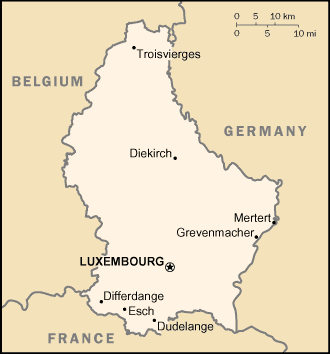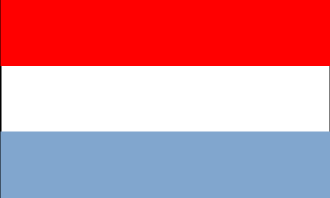
|
Luxembourg
Background:
Founded in 963, Luxembourg became a grand duchy in 1815 and an independent
state under the Netherlands. It lost more than half of its territory to Belgium
in 1839, but gained a larger measure of autonomy. Full independence was
attained in 1867. Overrun by Germany in both World Wars, it ended its
neutrality in 1948 when it entered into the Benelux Customs Union and when it
joined NATO the following year. In 1957, Luxembourg became one of the six
founding countries of the European Economic Community (later the European
Union) and in 1999 it joined the euro currency area.
Location:
Western Europe, between France and Germany.
Area: Total: 2,586 sq km, water: 0 sq km, land: 2,586 sq km.
Area - comparative: Slightly smaller than Rhode Island.
Land boundaries: Total: 359 km, border countries: Belgium 148 km, France 73
km, Germany 138 km.
Coastline: 0 km (landlocked).
Climate and Terrain:
Climate: Modified continental with mild winters, cool summers.
Terrain: Mostly gently rolling uplands with broad, shallow valleys; uplands to
slightly mountainous in the north; steep slope down to Moselle flood plain in
the southeast.
Elevation extremes: Lowest point: Moselle River 133 m, highest point:
Buurgplaatz 559 m.
Natural resources: Iron ore (no longer exploited), arable land
People:
Population: 448,569.
Ethnic groups: Celtic base (with French and German blend), Portuguese, Italian,
Slavs (from Montenegro, Albania, and Kososvo) and European (guest and resident
workers).
Religions: The greatest preponderance of the population is Roman Catholic with
a very few Protestants, Jews, and Muslims note: 1979 legislation forbids the
collection of religious statistics.
Languages: Luxembourgish (national language), German (administrative language),
French (administrative language).
Government:
Government type: Constitutional monarchy.
Capital: Luxembourg.
Independence: 1839 (from the Netherlands).
Economy overview:
This stable, high-income economy features solid growth, low inflation, and low
unemployment. The industrial sector, initially dominated by steel, has become
increasingly diversified to include chemicals, rubber, and other products.
Growth in the financial sector has more than compensated for the decline in
steel. Services, especially banking, account for a substantial proportion of
the economy. Agriculture is based on small family-owned farms. The economy
depends on foreign and trans-border workers for 30% of its labor force.
Although Luxembourg, like all EU members, has suffered from the global economic
slump, the country has maintained a fairly robust growth rate. On 1 January
2002, Luxembourg - together with 11 of its EU partners - began to replace its
circulating national currency with the euro.
GDP - composition by sector: Agriculture: 1%, industry: 30%, services: 69%,
Statistics:
Telephones - main lines in use: 314,700.
Telephones - mobile cellular: 215,741.
Radio broadcast stations: AM 2, FM 9, shortwave 2.
Radios: 285,000.
Television broadcast stations: 5.
Televisions: 285,000.
Internet users: 100,000.
Railways: Total: 274 km.
Highways: Total: 5,166 km, paved: 5,166 km, unpaved: 0 km.
Airports: 2, with paved runways: 1, with unpaved runways: 1.
Heliports: 1.
Return to Visiting Locations
|

